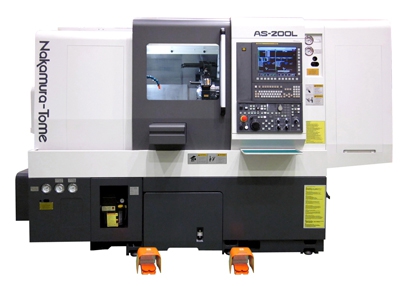
Methods Machine Tools Inc. has introduced the Nakamura-Tome AS-200LMY-S subspindle machine, a high-performance multitasking turning center. The new AS-200LMY-S offers an upgraded long bed with subspindle. The machine is equipped with a powerful milling drive, together with a high-speed, high-accuracy C-axis and 82mm stroke Y-Axis that ensures accurate, finished parts and eliminates deburring, milling, drilling and repositioning of fixtures.
"The new Nakamura AS-200LMY-S not only offers the quality our customers expect from Methods and Nakamura at a very competitive price point, but also offers a long bed with sub spindle that increases machining options," said Richard Parenteau, Director of Application Development/Nakamura-Tome at Methods Machine Tools.
Subspindle speed is approximately 6,000 RPM and distance between spindle noses is 31.50 inches (800mm). The machine offers a 7.5 hp milling motor on a 6,000 RPM, 12-station turret with ½ indexing, providing 24-tool capacity. Maximum turning diameter is 13.39 inches (340mm) and maximum turning length is 22.44 inches (570mm). The turning tool is 1.0 inch (25mm) and the inside boring shank is 1.25 inches (32mm). The Y-Axis enables turning, drilling and milling off center with full power on both the Nakamura AS-200 and the AS-200LMY-S multitasking center.
Providing very high rigidity, the AS-200LMY-S weighs in at a heavy 11,023 lbs (5,000 kg) and takes up approximately 59.4 square feet (5.5 sq. meters) of floor space.
The AS-200LMY-S features a 15" high-resolution color display LCD panel, which works in conjunction with the latest Fanuc 0iTD controller to give a high degree of functionality, coupled with fast processing speeds and 1 Mbyte of program storage length.
The AS-200 and the AS-200LMY-S come equipped with the NT Work Navigator that can recognize the coordinates of machine parts with non-round shapes such as those in forgings and castings, without any additional costs involved. This cost-cutting feature eliminates the need for costly positioning fixtures and clamping devices.
In addition, both AS-200 models feature an all-in-one software package, the NT Nurse II System. This software provides technicians with convenient, easily operated support for operation, programming and production on the machine. All Nakamura-Tome machines are equipped with an "airbag," a standard safety feature that greatly reduces the impact and force of a machine collision. Should a crash occur, within 8 milliseconds after the crash, servo motor-feeding direction is reversed and the machine will stop in EMG mode.
Contact Details
Related Glossary Terms
- boring
boring
Enlarging a hole that already has been drilled or cored. Generally, it is an operation of truing the previously drilled hole with a single-point, lathe-type tool. Boring is essentially internal turning, in that usually a single-point cutting tool forms the internal shape. Some tools are available with two cutting edges to balance cutting forces.
- gang cutting ( milling)
gang cutting ( milling)
Machining with several cutters mounted on a single arbor, generally for simultaneous cutting.
- milling
milling
Machining operation in which metal or other material is removed by applying power to a rotating cutter. In vertical milling, the cutting tool is mounted vertically on the spindle. In horizontal milling, the cutting tool is mounted horizontally, either directly on the spindle or on an arbor. Horizontal milling is further broken down into conventional milling, where the cutter rotates opposite the direction of feed, or “up” into the workpiece; and climb milling, where the cutter rotates in the direction of feed, or “down” into the workpiece. Milling operations include plane or surface milling, endmilling, facemilling, angle milling, form milling and profiling.
- shank
shank
Main body of a tool; the portion of a drill or similar end-held tool that fits into a collet, chuck or similar mounting device.
- turning
turning
Workpiece is held in a chuck, mounted on a face plate or secured between centers and rotated while a cutting tool, normally a single-point tool, is fed into it along its periphery or across its end or face. Takes the form of straight turning (cutting along the periphery of the workpiece); taper turning (creating a taper); step turning (turning different-size diameters on the same work); chamfering (beveling an edge or shoulder); facing (cutting on an end); turning threads (usually external but can be internal); roughing (high-volume metal removal); and finishing (final light cuts). Performed on lathes, turning centers, chucking machines, automatic screw machines and similar machines.







